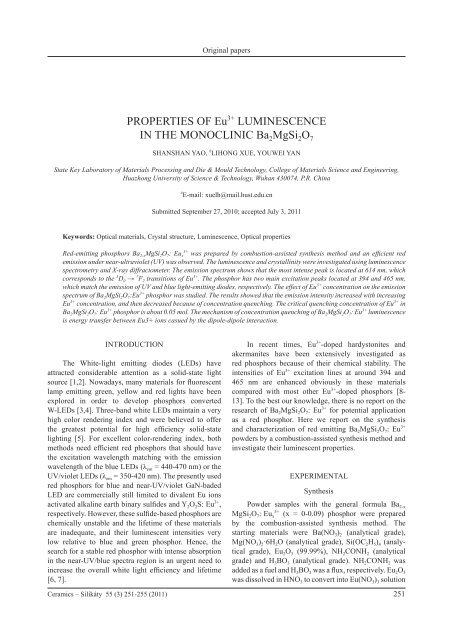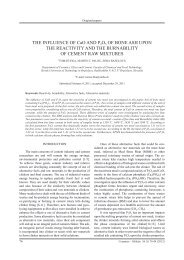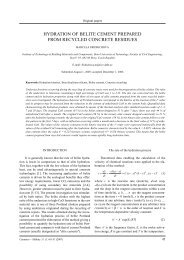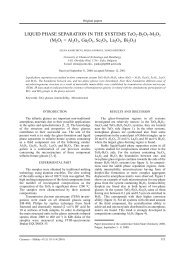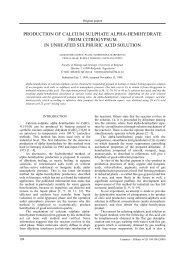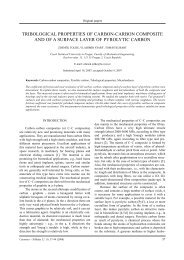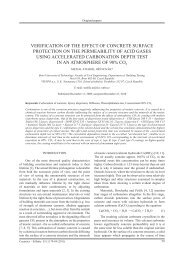PROPERTIES OF Eu3+ LUMINESCENCE IN ... - Ceramics-Silikaty
PROPERTIES OF Eu3+ LUMINESCENCE IN ... - Ceramics-Silikaty
PROPERTIES OF Eu3+ LUMINESCENCE IN ... - Ceramics-Silikaty
Create successful ePaper yourself
Turn your PDF publications into a flip-book with our unique Google optimized e-Paper software.
Original papers<br />
<strong>PROPERTIES</strong> <strong>OF</strong> Eu 3+ <strong>LUM<strong>IN</strong>ESCENCE</strong><br />
<strong>IN</strong> THE MONOCL<strong>IN</strong>IC Ba 2MgSi 2O 7<br />
SHaNSHaN YaO, # LIHONg XUE, YOUwEI YaN<br />
State Key Laboratory of Materials Processing and Die & Mould Technology, College of Materials Science and Engineering,<br />
Huazhong University of Science & Technology, Wuhan 430074, P.R. China<br />
# E-mail: xuelh@mail.hust.edu.cn<br />
Submitted September 27, 2010; accepted July 3, 2011<br />
Keywords: Optical materials, Crystal structure, Luminescence, Optical properties<br />
Red-emitting phosphors Ba 2-xMgSi 2O 7: Eu x 3+ was prepared by combustion-assisted synthesis method and an efficient red<br />
emission under near-ultraviolet (UV) was observed. The luminescence and crystallinity were investigated using luminescence<br />
spectrometry and X-ray diffractometer. The emission spectrum shows that the most intense peak is located at 614 nm, which<br />
corresponds to the 5 D 0 → 7 F 2 transitions of Eu 3+ . The phosphor has two main excitation peaks located at 394 and 465 nm,<br />
which match the emission of UV and blue light-emitting diodes, respectively. The effect of Eu 3+ concentration on the emission<br />
spectrum of Ba 2MgSi 2O 7:Eu 3+ phosphor was studied. The results showed that the emission intensity increased with increasing<br />
Eu 3+ concentration, and then decreased because of concentration quenching. The critical quenching concentration of Eu 3+ in<br />
Ba 2MgSi 2O 7: Eu 3+ phosphor is about 0.05 mol. The mechanism of concentration quenching of Ba 2MgSi 2O 7: Eu 3+ luminescence<br />
is energy transfer between <strong>Eu3+</strong> ions casued by the dipole-dipole interaction.<br />
<strong>IN</strong>TRODUCTION<br />
The white-light emitting diodes (LEDs) have<br />
attracted considerable attention as a solid-state light<br />
source [1,2]. Nowadays, many materials for fluorescent<br />
lamp emitting green, yellow and red lights have been<br />
explored in order to develop phosphors converted<br />
w-LEDs [3,4]. Three-band white LEDs maintain a very<br />
high color rendering index and were believed to offer<br />
the greatest potential for high efficiency solid-state<br />
lighting [5]. For excellent color-rendering index, both<br />
methods need efficient red phosphors that should have<br />
the excitation wavelength matching with the emission<br />
wavelength of the blue LEDs (λ em = 440-470 nm) or the<br />
UV/violet LEDs (λ em = 350-420 nm). The presently used<br />
red phosphors for blue and near-UV/violet gaN-baded<br />
LED are commercially still limited to divalent Eu ions<br />
activated alkaline earth binary sulfides and Y 2O 2S: Eu 3+ ,<br />
respectively. However, these sulfide-based phosphors are<br />
chemically unstable and the lifetime of these materials<br />
are inadequate, and their luminescent intensities very<br />
low relative to blue and green phosphor. Hence, the<br />
search for a stable red phosphor with intense absorption<br />
in the near-UV/blue spectra region is an urgent need to<br />
increase the overall white light efficiency and lifetime<br />
[6, 7].<br />
In recent times, Eu 3+ -doped hardystonites and<br />
akermanites have been extensively investigated as<br />
red phosphors because of their chemical stability. The<br />
intensities of Eu 3+ excitation lines at around 394 and<br />
465 nm are enhanced obviously in these materials<br />
compared with most other Eu 3+ -doped phosphors [8-<br />
13]. To the best our knowledge, there is no report on the<br />
research of Ba 2MgSi 2O 7: Eu 3+ for potential application<br />
as a red phosphor. Here we report on the synthesis<br />
and characterization of red emitting Ba 2MgSi 2O 7: Eu 3+<br />
powders by a combustion-assisted synthesis method and<br />
investigate their luminescent properties.<br />
EXPERIMENTaL<br />
Synthesis<br />
Powder samples with the general formula Ba 2-x<br />
MgSi 2O 7: Eu x 3+ (x = 0-0.09) phosphor were prepared<br />
by the combustion-assisted synthesis method. The<br />
starting materials were Ba(NO 3) 2 (analytical grade),<br />
Mg(NO 3) 2·6H 2O (analytical grade), Si(OC 2H 5) 4 (analytical<br />
grade), Eu 2O 3 (99.99%), NH 2CONH 2 (analytical<br />
grade) and H 3BO 3 (analytical grade). NH 2CONH 2 was<br />
added as a fuel and H 3BO 3 was a flux, respectively. Eu 2O 3<br />
was dissolved in HNO 3 to convert into Eu(NO 3) 3 solution<br />
<strong>Ceramics</strong> – Silikáty 55 (3) 251-255 (2011) 251
completely. The appropriate molar ratio of Ba(NO 3) 2,<br />
Mg(NO 3) 2·6H 2O, Eu(NO 3) 3, NH 2CONH 2 and H 3BO 3<br />
were dissolved in a minimum amount of distilled water<br />
to get a clear solution. Then a stoichiometric amount of<br />
Si(OC 2H 5) 4 dissolved in ethanol was added dropwise<br />
into the above solution under vigorous stirring. Si(OH) 4<br />
was formed by the hydrolysis of Si(OC 2H 5) 4 as follows:<br />
nSi(OC 2H 5) 4 + H 2O → nSi(OH) 4 + 4nC 2H 5OH<br />
The mixture solution was allowed to react at 80°C<br />
for 2 h to obtain a homogenous solution. and then the<br />
solution was introduced into a muffle furnace preheated<br />
at 600°C. within a few minutes, the solution boiled and<br />
was ignited to produce a self-propagating flame. The<br />
product obtained was post-annealed at 1000°C for 3 h.<br />
Sample characterization<br />
The synthesized phosphors were ground to powder<br />
and sieved by 200 mesh for characterization. The crystal<br />
phase of the synthesized powders prepared in the process<br />
was characterized by X-ray powder diffraction using<br />
an X′ Pert PRO X-ray diffractometer having a Cu Kα<br />
radiation (λ = 1.5406 Å) at 40 kV tube voltage and 40 mA<br />
tube current. The XRD patterns collected in the range of<br />
10° ≤ 2θ ≤ 90°. The excitation and emission spectra were<br />
performed on a RF-5301 fluorescence spectrophotometer<br />
equipped with a xenon discharge lamp as an excitation<br />
source. The excitation and emission slits were set<br />
to 3.0 nm. all the above measurements were taken at<br />
room temperature.<br />
The chromaticity coordinates were obtained according<br />
to the Commission International de l'Eclairage<br />
(CIE) using a Spectra Lux Software v.2.0 Beta [14, 15].<br />
RESULTS aND DISCUSSION<br />
Crystal structure<br />
The crystal structure of Ba 2MgSi 2O 7 is composed<br />
of a tetrahedron framework, [Mg 2Si 2O 7], and isolated<br />
barium atoms. Two silicon tetrahedral are connected by<br />
sharing an oxygen, forming a di-silicate group Si 2O 7[16].<br />
all of the barium atoms are located in the channel and<br />
coordinated by oxygen atoms in both the structures<br />
(Figure 1).<br />
Phase formation<br />
The stoichiometric composition of the redox<br />
mixture was calculated based on the total oxidizing<br />
and reducing valence of the oxidizer and the fuel. For<br />
the combustion synthesis of oxides, metal nitrates are<br />
employed as oxidizer and urea is employed as a reducer<br />
[17]. with the calculation of oxidizer to fuel ratio, the<br />
Yao S., Xue L., Yan Y.<br />
elements were assigned formal valences as follows:<br />
Ba = +2, Mg = +2, Eu = +3, Si = +4, B = +3, C = +4,<br />
H = +1, O = -2 and N = 0. accordingly, the oxidizer and<br />
fuel values for various reactants are as given below:<br />
For complete combustion, the oxidizer and the fuel<br />
serve as a numerical coefficient for the stoichiometric<br />
balance, so that the equivalence ratio is equal to unity (total<br />
oxidizing valency / total reducing valency (O/F) = 1), and<br />
the maximum energy is released [18]. Thus, the molar<br />
ratio of the reactants taken is 1.95:1:0.05:2:0.06:5 for Ba<br />
(NO 3) 2:Mg(NO 3) 2:Eu(NO 3) 3:Si(OH) 4:H 3BO 3:CO(NH 2) 2.<br />
Owing to the combustion process, the solution boiled<br />
and dehydrated, followed by decomposition with escape<br />
of large amounts of gases (oxides of carbon, nitrogen<br />
and ammonia), then spontaneous ignition occurred<br />
and underwent smoldering combustion with enormous<br />
swelling. The whole combustion process was over within<br />
less than 5 min. after the combustion, the ashes were<br />
cooled to room temperature. Finally, the ashes obtained<br />
were post-annealed at 1000°C for 3 h.<br />
The XRD patterns of our samples, Ba 2-xMgSi 2O 7:<br />
Eu x 3+ (x = 0-0.09), are shown in Figure 2, which indicated<br />
that doped Eu 3+ ions have no obvious influence on the<br />
structure of the host. a pure phase of the monoclinic<br />
Ba 2MgSi 2O 7 has formed in these samples. The fraction<br />
peak positions and the relative intensities of the prepared<br />
samples are well matched with that in the literature. The<br />
layered structure, with the following cell parameters:<br />
a = 8.4128 Å, b = 10.7101 Å, c = 8.4387 Å, β = 110.71°,<br />
consists of discrete [Si 2O 7] 6- units connected by tetrahedral<br />
coordinated Mg 2+ and eight-coordinated Ba 2+<br />
ions [16]. No trace of the previously reported tetragonal<br />
Ba 2MgSi 2O 7 phase could be observed in the XRD<br />
patterns [19]. In this work, the structure of monoclinic<br />
Ba 2MgSi 2O 7 with space group C2/c was taken as the<br />
starting model for the synthesized phosphors.<br />
Figure 1. Crystal structure of Ba 2MgSi 2O 7.<br />
252 <strong>Ceramics</strong> – Silikáty 55 (3) 251-255 (2011)
The lattice parameters listed in Table 1 shows<br />
that there is good agreement between the literature and<br />
the prepared Ba 2MgSi 2O 7 and Ba 2-xMgSi 2O 7: Eu x 3+<br />
(x = 0.01-0.09) samples values, suggesting that the<br />
method starting form the silicates are successfully<br />
applied here. Meanwhile, it is clear that the Eu 3+ doping<br />
ions do not change the general structure.<br />
an acceptable percentage difference in ion radii<br />
between doped and substituted ions must not exceed<br />
30 % [20]. The calculations of the radius percentage<br />
difference (D r) between the doped ions (Eu 3+ ) and the<br />
possible substituted ions (Ba 2+ , Mg 2+ , Si 4+ ) in Ba 2MgSi 2O 7<br />
are summarized in Table 2. The values are based on the<br />
following formula<br />
where CN is the coordination number, R m(CN) is the<br />
radius of host cation, and R d(CN) is the radius of doped<br />
Relative intensity (a.u.)<br />
110<br />
020<br />
200<br />
211<br />
220<br />
131<br />
202<br />
013<br />
10 20 30 40 50<br />
2θ (°)<br />
Figure 2. XRD patterns of Ba 2-xMgSi 2O 7: Eu x 3+ (x = 0, 0.01,<br />
0.03, 0.05, 0.07, and 0.09) phosphors.<br />
Properties of Eu 3+ luminescence in the monoclinic Ba 2MgSi 2O 7<br />
3+<br />
Ba MgSi O : Eu 2-x 2 7 x<br />
x = 0.09<br />
x = 0.07<br />
x = 0.05<br />
x = 0.03<br />
x = 0.01<br />
x = 0<br />
60 70 80 90<br />
ion. The value of Dr between Eu 3+ and Ba 2+ on eightcoordinated<br />
sites is 24.93 %. while that between Eu 3+<br />
and Mg 2+ (or Si 4+ ) is -66.14 % (or-264.23%). Obviously,<br />
the doping ions of Eu 3+ will clearly substitute the barium<br />
sites.<br />
as trivalent Eu 3+ ions are doped into Ba 2MgSi 2O 7,<br />
they would non-equavalently replace the alkaline earths<br />
ions. In order to keep the charge balance, two Eu 3+ ions<br />
would be needed to substitute for three alkaline earths<br />
ions (the total charge of two trivalent Eu 3+ ions is equal<br />
to that of three alkaline earths ions). Hence, one vacancy<br />
defect of V Ba’’ with two negative charges, and two positive<br />
defects of Eu Ba· would be created by each substitution of<br />
every two Eu 3+ ions in the compound. The vacancy V Ba’’<br />
would act as a donor of electrons, while the two Eu Ba·<br />
defects become acceptors of the electrons. Consequently,<br />
the negative charges in the vacancy defects of V Ba’’ would<br />
be transferred to the Eu 3+ sites. The whole process can be<br />
expressed by the following equation [22]:<br />
3Ba 2+ + 2Eu 3+ → V" Ba + 2Eu Ba·<br />
V" Ba → V Ba x + 2e<br />
2Eu Ba· + 2e → 2Eu Ba x<br />
Luminescent properties<br />
The effect of Eu 3+ concentration on emission intensity<br />
of Ba 2MgSi 2O 7: Eu 3+ phosphor excited by different<br />
excitation wavelengths is shown in Figure 3, in which<br />
the Eu 3+ concentration varies from 0.01 mol to 0.09 mol.<br />
It can be observed that the emission intensities increase<br />
with increasing Eu 3+ concentration, and then decrease<br />
because of the concentration quenching, and reach the<br />
maximal value at 0.05 mol.<br />
Table 1. Lattice parameters values of Ba 2-xMgSi 2O 7: Eu x 3+ (x = 0, 0.01, 0.03, 0.05, 0.07, 0.09) phosphors calculated from the XRD<br />
pattern.<br />
Samples a (Å) b (Å) c (Å) V (Å 3 )<br />
Ba2MgSi2O7 (this work) 8.2059 10.4516 8.3002 698.82<br />
3+ Ba1.99MgSi2O7: Eu0.01 8.1996 10.4433 8.2920 695.27<br />
3+ Ba1.97MgSi2O7: Eu0.03 8.1822 10.4195 8.2852 693.46<br />
3+ Ba1.95MgSi2O7: Eu0.05 8.1613 10.3976 8.2621 691.83<br />
3+ Ba1.93MgSi2O7: Eu0.07 8.1436 10.3811 8.2510 689.52<br />
3+ Ba1.91MgSi2O7: Eu0.09 8.1288 10.3679 8.2303 687.62<br />
Reference [16] 8.4128 10.7101 8.4387 711.20<br />
Table 2. Ionic radii difference percentage (Dr) between matrix cations and doped ions.<br />
Dr = [Rm(CN)-Rd(CN)]/Rm(CN) (%)<br />
2+ 2+ 4+<br />
Doped ions Rd(CN) (Å) RBa (8) = 1.42 (Å) RMg (4) = 0.57 (Å) RSi (4) = 0.26 (Å)<br />
Eu 3+ 0.947 (6) - 66.14 -264.23<br />
1.066 (8) 24.93<br />
<strong>Ceramics</strong> – Silikáty 55 (3) 251-255 (2011) 253
Relative intensity (a.u.)<br />
Figure 3. Emission intensity vs europium concentration (x) of<br />
Ba 2-xMgSi 2O 7: Eu x 3+ phosphor under various excitation wavelengths<br />
(λ em = 614 nm).<br />
The emission intensity (I) per activator ion follows<br />
the equation [22, 23]:<br />
where x is the activator concentration; Q = 6, 8, 10 for<br />
dipole-dipole(d-d), dipole-quadrupole(d-q), quadrupolequadrupole(q-q)<br />
interactions, respectively; and K and<br />
β are constant for the same excitation conditions for a<br />
given host crystal. The critical concentration of Eu 3+<br />
has been determined to be 0.05 mol. The dependence<br />
of the emission intensity of Ba 2MgSi 2O 7: Eu 3+ phosphor<br />
excited at 394 nm as a function of the corresponding<br />
concentration of Eu 3+ for concentration greater than<br />
the critical concentration is determined. The polt of<br />
lg I/x Eu 3+ as a function of lg x Eu 3+ in Ba 2-xMgSi 2O 7: Eu x 3+<br />
phosphor are shown in Figure 4. It can be seen that<br />
dependence of lg x Eu 3+ on lg I/x Eu 3+ is linear and the slope<br />
is -1.989. The value of Q can be calculated as 5.967,<br />
which is close to 6. The result indicates that the con-<br />
centration self-quenching mechanism of Eu 3+ luminescence<br />
in Ba 2MgSi 2O 7 is the d-d interaction.<br />
3+<br />
lg I/x Eu<br />
λ ex = 394 nm<br />
λ ex = 465 nm<br />
λ ex = 381 nm<br />
λ ex = 362 nm<br />
λ ex = 413 nm<br />
0 0.02 0.04 0.06 0.08 0.1<br />
Eu concentration (x)<br />
6.0<br />
5.5<br />
5.0<br />
4.5<br />
4.0<br />
3.5<br />
-2.0 -1.8 -1.6<br />
3+ lg xEu -1.4 -1.2<br />
Figure 4. Plot of lg I/x 3+<br />
Eu as a function of 1 lg x 3+<br />
Eu in Ba2 3+<br />
xMgSi2O7: Eux phosphors (λex = 394 nm).<br />
Yao S., Xue L., Yan Y.<br />
-1.0<br />
The excitation spectra of Ba 1.95MgSi 2O 7: Eu 0.05 3+<br />
is measured in the wavelength range of 260-465 nm by<br />
monitoring with the intense red emission located at 614<br />
nm (Figure 5a). The excitation spectra consist of two<br />
intense bands at 394 and 465 nm in addition to three<br />
relatively weak bands peaking about 362, 381, and 413<br />
nm. The bands peaking around 362, 394 and 465 nm are<br />
assigned to transition from the 7 F 0 level to the 5 D 4, 5 L 6,<br />
and 5 D 2 levels of f-f transitions of Eu 3+ , respectively. On<br />
the other hand, rest of the bands peaking around 381 and<br />
413 nm are assigned to the transitions from the thermal<br />
populated 7 F 1 level to the 5 F 4 and 5 L 3 [24, 25]. The strong<br />
broad band peaking at 394 nm and the narrow band at<br />
465 nm correspond to the characteristic f-f transitions<br />
of Eu 3+ within its 4 f 6 configuration. Figure 5b shows<br />
the emission spectral of as-synthesized Eu 3+ -doped<br />
Ba 2MgSi 2O 7 phosphors. The spectrum exhibits two main<br />
peaks centered at 591 and 614 nm, which come from the<br />
transitions of 5 D 0→ 7 F 1 and 5 D 0→ 7 F 2, respectively. The<br />
most intense emission is the 5 D 0→ 7 F 2 transition located<br />
at 614 nm, corresponding to the red emission, in good<br />
accordance with the Judd-Ofelt theory [24]. Therefore,<br />
strong red emission can be observed. The main excitation<br />
peaks indicate the phosphor is very suitable for a color<br />
converter using UV lights as the primary light source. It<br />
can be used as a red phosphor excited by UV-LED chip<br />
and would have applications in the solid-state lighting<br />
field.<br />
a) λ em = 614 nm b)<br />
300 400 500 600 700<br />
Wavelength (nm)<br />
λ ex = 394 nm<br />
3+<br />
Figure 5. Photoluminescence spectra of Ba1.95MgSi2O7: Eu0.05 phosphor.<br />
Color purity can be visualized in the chromaticity<br />
diagram (Figure 6) as blue, red, and green regions,<br />
using the color coordinates of the luminescent material<br />
emission. So, from the luminescence emission spectra<br />
of Ba 1.95MgSi 2O 7:Eu 0.05 3+ sample we obtained the<br />
chromaticity coordiantes with the aid of the Spectra Lux<br />
Software v.2.0 Beta [14]. For any given color there is<br />
one setting for each three number X, Y and Z known as<br />
254 <strong>Ceramics</strong> – Silikáty 55 (3) 251-255 (2011)<br />
Relative intensity (a.u.)<br />
λ ex = 465 nm<br />
λ ex = 381 nm<br />
λ ex = 362 nm<br />
λ ex = 413 nm<br />
800
tristimulus values that will produce a match. Based on<br />
emission spectra of Ba 1.95MgSi 2O 7:Eu 0.05 3+ sample, the<br />
(x, y) color coordinates were determined with the<br />
following values (x, y) = (0.623, 0.376).<br />
Figure 6. Chromaticity coordinates calculated from emission<br />
spectra of the Ba 1.95MgSi 2O 7: Eu 0.05 3+ , (λex = 394 nm).<br />
CONCLUSIONS<br />
The monoclinic Ba 2MgSi 2O 7: Eu 3+ phosphors were<br />
synthesized by combustion-assisted synthesis method<br />
and its luminescent properties were also investigated.<br />
In this akermanites crystal structures, the doping ions<br />
of Eu 3+ will clearly substitute the alkaline earth metal<br />
(Ba 2+ ) ions. with an increase in the Eu 3+ concentration,<br />
quenching of Eu 3+ luminescence occurs. The critical<br />
quenching concentration of Eu 3+ in Ba 2MgSi 2O 7: Eu 3+<br />
phosphor is determined as 0.05 mol. The mechanism<br />
of concentration quenching of Ba 2MgSi 2O 7: Eu 3+<br />
luminescence is energy transfer between Eu 3+ ions casued<br />
by the dipole-dipole interaction. The CIE chromaticity<br />
coordinates of the optimized sample was calculated, (x,<br />
y) = (0.623, 0.376). The excitation spectrum couples<br />
well with the emission of UV-LED chips (380-410 nm).<br />
The results indicated that Ba 2MgSi 2O 7: Eu 3+ is a potential<br />
red phosphor for phosphor-converted UV-LEDs.<br />
acknowledgement<br />
This work was supported by the Natural Science<br />
Foundation of China (No.51002054), the Natural<br />
Science Foundation of Hubei Province of China<br />
(No.2008CB252), the Fundamental Research Funds<br />
Properties of Eu 3+ luminescence in the monoclinic Ba 2MgSi 2O 7<br />
for the Central Universities (C2009Q012) and by the<br />
Scientific Research Foundation for the Returned<br />
Overseas Chinese Scholar, State Education Ministry.<br />
References<br />
1. Schubert E.F., Kim J.K.: Science 308, 1274 (2005).<br />
2. Feldmann C., Jüstel T., Ronda C.R., Schmidt P.J.: adv.<br />
Funct. Mater. 13, 511 (2003).<br />
3. Xie R.J., Hirosaki N.: Sci. Technol. adv. Mater. 8, 588<br />
(2007).<br />
4. Kim J.S., Jeon P.E., Park Y.H., Choi J.C., Park H.L., Kim<br />
G.C., Kim T.W.: Appl. Phys. Lett. 85, 3696 (2004).<br />
5. Nishida T., Ban T., Kobayashi N.: Appl. Phys. Lett. 82,<br />
3817 (2003).<br />
6. Chou T.w., Mylswamy S., Liu R.S., Chuang S.Z.: Solid<br />
State Commun. 136, 205 (2005).<br />
7. Sivakuar V., Varadaraju U.V.: J. Electrochem. Soc. 152,<br />
H168 (2005).<br />
8. Yao S.S., Li Y.Y., Xue L.H., Yan Y.w.: Eur. Phys. J. appl.<br />
Phys. 48 , 20602/1-4 (2009).<br />
9. Yao S.S., Xue L.H., Yan Y.w., Li Y.Y., Yan M. F.: J. Ceram.<br />
Process. Res. 11, 669 (2010).<br />
10. wan J.X., wang Z.H., Chen X.Y., Mu L., Qian Y.T.: Eur. J.<br />
Inorg. Chem. 20, 4031 (2005).<br />
11. wan J.X., Yao Y.w., Tang g.Y., Qian Y.T.: J. Nanosci<br />
Nanotechnol. 8, 1449 (2008).<br />
12. Yao S.S., Xue L.H., Yan Y.w., Yan M.F.: J. am. Ceram.<br />
Soc. (2010). Doi: 10.1111/j.1551-2916.2010.04261.x<br />
13. Yao S.S., Li Y.Y., Xue L.H., Yan Y.w.: Int. J. appl. Ceram.<br />
Technol. (2009) Doi: 10.1111/j.1744-7402.2009.02447.x.<br />
14. Satnta a.P.C., Teles S. F.: Spectra Lux Software v.2.0 Beta,<br />
Photo. Quânticao Nanodispositivos, Renami 2003.<br />
15. Maia A.S., Stefani R., Kodaira C.A., Felinto M.F.C.,<br />
Teotonio E.E. S., Felinto M.C.F.C.: Opt. Mater. 31, 440<br />
(2008).<br />
16. aitasalo T., Hölsä J., Laamanen T., Lastusaari M., Lehto<br />
L., Niittykoski J., Pellé F.: Z. Kristallogr. Suppl. 23, 481<br />
(2006).<br />
17. Ekamabaram S., Maaza M.: J. alloy. Compd. 395, 132<br />
(2005).<br />
18. Kingsley J.J., Patil K.C.: Mater. Lett. 6, 427 (1988).<br />
19. aitasalo T., Hölsä J., Laamanen T., Lastusaari M., Lehto L.,<br />
Niittykoski J., Pellé F.: <strong>Ceramics</strong>-Silikáty 49, 58 (2005).<br />
20. Pires a.M., Davolos M.R.: Chem. Mater. 13, 21 (2001).<br />
21. Liebau F.: Structural Chemistry of Silicates, Structure,<br />
Bonding and Classification, Springer-Verlag, Berlin 1985.<br />
22. Pei Z.w., Su Q., Zhang J.Y.: J. alloys Compd. 198, 51<br />
(1998).<br />
22. Van Uitert L.g.: J. Electrochem. Soc. 114, 1048 (1967).<br />
23. Ozawa L.J., Jaffe P.M.: J. Electrochem. Soc. 118, 1678<br />
(1971).<br />
24. Kang Y.C., Chung Y.S., Park S. B.: J. Am. Ceram. Soc. 82,<br />
2056 (1999).<br />
25. Carnall W.T., Fields P.R., Rajnak K.: J. Chem. Phys. 49,<br />
4450 (1968).<br />
26. Judd B.R.: Phys. Rev.: Condens. Matter. 127, 750 (1962).<br />
<strong>Ceramics</strong> – Silikáty 55 (3) 251-255 (2011) 255


